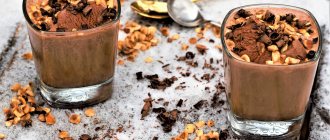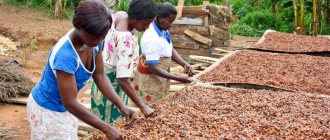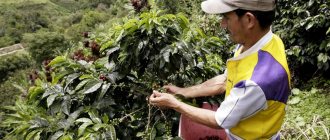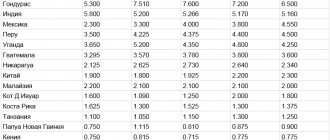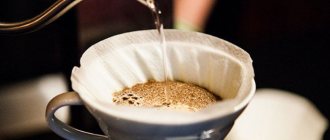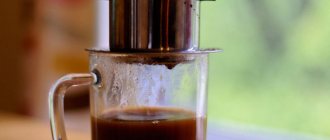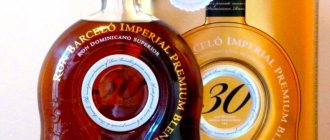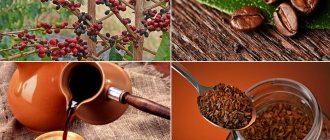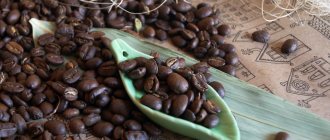Types of coffee
Add a comment
Good day, site visitors! Coffee is a favorite drink in different parts of the world, different nationalities and levels of life. Almost everyone loves this delicacy, as it invigorates, relieves depression, prevents certain diseases and lifts the mood. Despite the popularity of the drink in the world, people know little about the origin of coffee, but this is very interesting. Thus, Brazilian coffee is one of the main types supplied to various countries. Its exports account for a third of all coffee beans grown in the world.
Brazilian coffee has its own origin, processing and preparation method, and culture. It has a unique taste, for which it is so loved all over the world.
We recommend drinking this drink from the Czech Leander porcelain set
History of Brazilian coffee
Now ask any schoolchild what he knows about coffee, and you will get an instant answer: Brazil is the country of coffee. But we will try to dispel doubts about the origin of this plant.
Few people know that the coffee bush was brought to Brazil illegally, through intrigue, love and seduction of women. At the beginning of the eighteenth century, diplomat Francisco de Melo Palheta used all his charm to carry out the order of his government and bring a coffee tree to the territory of his country at all costs, and the governor’s wife could not resist Francisco’s charms, subsequently giving him the coveted bush .
So in Brazil they began to grow coffee for their own needs, and from the mid-eighteenth century the real coffee boom of Brazil began, exporting coffee to America and Europe. People quickly liked the beans, which had invigorating properties, and coffee production in Brazil gained unprecedented momentum. In the mid-twentieth century, Brazilian coffee accounted for almost 40 percent of total world production.
Due to the increase in industrial production volumes, workers were required. People began to migrate from all over the world to provide inexpensive labor, and the beginning of the twentieth century marked the second coffee boom in Brazil. It is known under the slogan Coffee with milk. It was on these two products that the country's economic growth was based.
During this period, the country processed an incredible amount of coffee, the market was oversaturated, the government was forced to increase the price of Brazilian coffee and banned exports to other countries until the price returned to its previous positions.
By 1920, Brazil had become virtually the only coffee-producing country, accounting for eighty percent of the world's coffee industry. But in the early fifties, other countries began to produce coffee no worse than Brazil, and foreign coffee gradually began to displace the main monopolist.
Tastes in coffee have changed, and a softer taste and refined aroma have become valued. Brazilian coffee, produced in huge quantities, began to suffer from competition. Other states demanded that export standards be reduced. Now Latin Americans are investing heavily in coffee production, which allows them not to lose their position and remain a leader in the coffee industry.
Export of Arabica and Robusta coffee from Brazil
It is difficult to call this product an essential item. However, over the years, it continues to win the hearts of the peoples of the world and is officially an integral part of the Brazilian consumer basket (in 2012, per capita consumption of ground coffee was 4.98 kg). Served hot or cold, the Arabica Brazil coffee drink prepared according to different recipes makes the life of a coffee lover brighter and more interesting. Its original taste and aroma make you forget about everything for a moment and plunge into a sea of aroma and taste pleasure.
Coffee exports from Brazil were not stable from its inception until the 2000s. Sales success was followed by crises in coffee production within the country. If at the beginning of the 19th century the active supply of this product to the market contributed to the development of the country, then already in 1870 there were not enough workers, and the demand for immigrant labor increased. In 1906, the Brazilians were unable to export all their coffee beans and, as a result, prices for the product fell. In the period from 1920 to the 1960s, Brazilian coffee, the varieties of which were already distinguished by their diversity, accounted for about 80% of the world's coffee. However, over time, production decreased slightly, but did not weaken.
Method of growing and processing raw materials
There are no high mountainous regions in Brazil, so coffee grows on plantations, the taste of which is soft and strong. It is generally accepted that the higher the fruits grow, the richer their taste, but despite this opinion, Brazil does not give up its leadership in the production of coffee beans. The advantage of Brazilian coffee is the lack of sourness, which not everyone likes, due to the area where it grows.
In this country, in most cases, the dry harvesting method is used, leaving the grains to dry in the open air for several weeks. Dry grains turn brown. Then the peeling procedure takes place.
Then they are sifted through several sieves of different diameters, distributing the grains by size. A small amount of beans are processed wet, which significantly increases the cost of the finished coffee beans.
Coffee connoisseurs do not particularly appreciate the taste of Brazilian coffee, since there is no zest in it, it is a simple, tasty and strong drink that can simply invigorate, but they do not get much pleasure from the drink.
The main products produced here are Arabica and Robusta. Robusta is ideal for making espresso, the most common and frequently ordered coffee in the world, the export of Robusta supplies one in three cups of the population.
In order to give the coffee different shades, Brazilian coffee beans are mixed with spices. But before you buy a package of coffee, carefully read the ingredients.
It is unlikely that any ordinary coffee lover will be able to distinguish the type of coffee in a drink; only true gourmets can do this, so Brazilian coffee is perfect for an every day morning ritual.
Coffee growing regions in Brazil
Minas Gerais (state)
Brazil's largest state, Minas Gerais, in the southeast of the country, is home to Brazil's highest mountains, providing a favorable altitude for cultivation and almost 50% of the country's coffee is produced there.
Main coffee growing regions:
Sul di Minas (region)
Historically, this region has been home to many coffee producers, and small farms have been worked here for generations. This is probably why there are so many cooperatives in the region and about 30% of the country's coffee is produced here. Despite the predominance of small farms (10 to 100 hectares), it is an industrialized area where mechanized harvesting is common.
Recently, some areas of the region, such as Carmo di Minas, have attracted special attention. In this municipality, located near the small village of Carmo, many producers try to make the most of the soil and climate to produce good coffee.
Altitude: 700-1350 meters Average temperature: ≈22°C Harvest: May-September Varieties and varieties: Catuaí, Mundo Novo, Icatu, Obatã, and Catuaí Rubi Flavor profile: coffee with light lemon notes and fruity aromas.
Cerrado di Minas (region)
Cerrado de Minas became the first coffee producing region in Brazil to receive the status of “Single region” (Cerrado Mineiro), i.e. coffee grown in a specific region of that country.
Cerrado means tropical savanna. Although this word refers to the entire savanna stretching across many states of Brazil, in relation to coffee the word is assigned to the Cerrado region. It is a large region consisting of 55 municipalities located between Alto Paranaiba, Triangulo Mineiro and northwestern Minas Gerais. Coffee began to be grown here relatively recently, and this may be why there are so many large mechanized farms in the region (from 2 to 300 hectares). About 90% of local farms occupy an area of more than 10 hectares.
Altitude: 800-1300 meters Wet summers and mild and dry winters – the region is well suited for specialty coffee production Harvest: May-September Varieties and varieties: Mundo Novo, Catuaí Flavor profile: Higher acidity coffee with medium body and sweetness.
BRAZIL FINE CUP
The taste of Brazilian coffee
The popularity of Brasilia coffee is limitless, but the taste and aroma remain mediocre. It does not represent any sophistication, however, it is perfect for everyday use. Despite the simplicity of taste, Brazilian coffee is extremely popular. It is used to make such a simple, but so often ordered espresso.
The famous Santos coffee is considered the most popular; it is quite good in both taste and smell. This brand is exported to many countries and it is believed that the Santos coffee brand is the best Brazilian coffee. Another type of coffee is Bourbon Santos, which has clove notes in its taste. It is available in instant and grain form.
Instant coffee is made from failed beans that are not suitable for sale as beans. But for lovers of a very quick morning cup of coffee, instant bourbon Santos is in great demand not only all over the world, but also in the Russian Federation.
Types and varieties of Brazilian coffee
There are not so many types of coffee around the world, so coffee plantations in Brazil are planted with Arabica and Robusta, which are familiar to us, in a ratio of 80:20. The influence of the first violin of the coffee business is so great that if the harvest decreases, the cost of coffee around the world will increase, despite the yield in other countries.
Kinds
Espresso is mainly made from Brazilian coffee. The types of coffee are affected by the area of cultivation, Arabica varieties, the size and color of the fruit itself, and the parameters of the richness of taste and aroma.
Brazilian coffee, the best varieties
The diversity of Brazilian coffee varieties does not in any way affect the sustainable cultivation of only two types - Brazilian Arabica and Robusta, and the more capricious Arabica is grown by a significant margin more than the primitive Robusta. For Arabica beans, elevated areas with a dry climate are preferred so that the beans are harder.
Coffee beans contain a small amount of caffeine, but they have a unique aroma that robusta is incapable of. Robusta grows in low bushes in low-lying areas of the country, but its beans contain more caffeine, making it ideal for an invigorating morning drink.
Quality control is carried out at every stage of harvesting and processing, right up to packaging. Since Brazil has many competitors, and quite justified ones, Brazilian manufacturers have no right to make mistakes in quality. And every year the quality of products is valued more than quantity.
It is not possible to single out the best type of coffee, since experts have divided their opinions, but we will try to present the line of the most popular varieties as follows.
- Brazil Santos coffee is the most popular variety of Brazilian coffee. It consists of several varieties, combining all the delicacy and delicacy of the drink. In regular sales you can find Santos coffee of the fourth grade. The first grade is more the exception than the rule.
- Maragogyp coffee is a combination variety with large beans.
- Brazil Iponema Rubi - This coffee grows in the highest mountainous areas and is popular in Latin American countries.
- Brazil yellow bourbon is a gourmet find, produced in its pure form.
- Brazil mogiana coffee is a type of specialized variety that has a fine line between sweetness and sourness.
Coffee Santos
This variety ranks first in popularity due to its taste and affordable price. It is a descendant of the old Arabica and grows mainly in the south.
Variety Minas
It has a specific smell due to the soil on which it grows, it is used in blends, it is not considered as a single variety, and it has a tart taste.
Maragogyp
It is distinguished by its large fruit size. Ambiguous expert opinion. But he did not leave anyone indifferent. It has a rather rough taste.
Variety Paransky
In the line of varieties of Parano coffee (and there are seven of them), the fifth is the most sold. This variety is not as high quality as the previous ones, but it is much cheaper. Paransky is named after the name of the port. Many varieties are named after the area in which they are grown, and the Paranan variety is no exception. Brazil even named the coffee brand brazil, after the entire country.
Features of cultivation
Brazilian coffee gets its excellent taste and aroma partly from its characteristic climate and the location of the trees themselves. Brazilian plantations are located on plains or slight hills, which gives the wonderful drink velvety and softness. Also because of this, the coffee lacks sourness in the aftertaste.
After the ripened grains are collected from the trees, they are laid out in a thin layer on the sunny side of the plain and left for 10-15 days to dry. This method is called dry processing. When the coffee beans have dried and become brownish in color, the top layer is removed. After this procedure, the fruits are sorted by size through a special sieve with holes of different diameters.
The dry processing method allows you to reduce financial costs and consumption of running water. This affects the cost of the product prepared in this way. In total, one third of all finished raw materials is produced using the dry method, the rest undergoes wet processing.
How to prepare Brazilian coffee
For coffee lovers, there is not much difference in the words Brazil and coffee. The country has the right to be considered one of the most coffee-drinking countries in the world. Brazilians brew coffee simply and tastefully. Here are some examples of how ordinary people brew coffee:
Take a paper or fabric filter and add a couple of tablespoons of ground coffee, pour in very hot water and wait a few minutes. Add the necessary spices, sugar, cream or milk. The procedure is over and you can enjoy.
Another method of preparing traditional Brazilian coffee takes a little longer, but the result is worth the time spent:
Place a few pieces of dark chocolate in a cup. Pour espresso. Then add hot milk, beat in a blender until foam forms and decorate the drink with cream.
But first of all, you need to know what you cannot do without making a delicious cup of coffee.
- select coffee beans of exceptional quality, they must be properly roasted and stored properly
- use only freshly ground, medium-ground grains
- After adding spices or other additives, it is recommended to pass the drink through a filter
In fact, Brazilians have many recipes for brewing coffee, but the most popular are the following:
- With chocolate and cream : put 50 grams of dark chocolate in 100 grams of espresso, add sugar according to your preference, pour in 200 grams of milk, then beat the mixture well and pour into tall glasses, garnish with whipped cream and grated chocolate chips.
- With cocoa and ice cream: boil cocoa, add sugar and a little salt (salt breaks up the sweet taste), whisk the cocoa thoroughly and pour into a cup. Pour 100 grams of espresso into the cocoa in a small stream, add ice cream. All! Enjoy.
The fastest recipe
To quickly make coffee you don’t need any special tricks. All you need is a multi-use or disposable filter, freshly ground high-quality coffee and water. The water should first boil, but do not rush to pour boiling water. Pour a few tablespoons of ground grains into the filter and fill with slightly cooled water. If you add your favorite spices, don’t be lazy and strain the drink. Add sugar and cream to taste and bask in the aroma and taste.
Famous brands of Brazilian coffee
Volcanica Coffee, Ferris Coffee, Fresh Roasted Coffee. The last brand on the list is unroasted coffee.
Interesting Facts
- Brazil is not only the world's coffee tycoon, but also the world's consumer. It competes with Ethiopia.
- The worst Brazilian coffee beans are processed into instant coffee. Brazil exports instant coffee in the amount of ten to twenty percent.
- Frosts occur in Brazil. This affects the yield.
- There are still slave-like working conditions on the plantations of this country.
- Some Brazilian coffee may smell fruity due to the way it is grown.
- The older the tree, the cheaper the coffee collected from it costs.
- In Santos Yellow Bourbon, the berries are yellow rather than the usual red.
- Santos packages feature a photograph of the coffee bean in its original size.
- With the wet harvesting method, grains are more expensive.
- Farmers sell not only bean coffee, but also ground coffee. Brazil adds all kinds of spices to its ground coffee to give its coffee a more refined aroma.
Cooking rules
Brazilian coffee can be brewed according to various recipes and with the addition of various ingredients. The specific choice will depend only on individual taste preferences and the availability of certain products. But it is worth remembering that before you start preparing the drink, it is important to study all the basic rules for brewing it.
- It is necessary to take only high-quality and fresh ingredients and grains.
- In order to get a fresh and rich taste and aroma, you should take Brazilian coffee that is coarsely ground or whole beans. It is recommended to grind it only before use.
- If other ingredients are added to the coffee drink, then after brewing it should be filtered.
- It is very important to correctly calculate the proportions of ingredients and their ratio. So, for 150 ml of water you need to take no more than 10-15 grams of Brazilian coffee beans.
- It is recommended to boil water before use.
Brazil is a magnificent country, with its own traditions, wonderful people and amazing nature. But still, according to coffee lovers, its main advantage remains the cultivation and processing of coffee beans. It was this production that provided Brazil with recognition and fame around the world. Many people today can no longer imagine life without this wonderful drink. But one third of all coffee produced is grown in this wonderful country.
Of course, coffee is highly valued by the Brazilians themselves. Even the poorest families cannot begin their day without a cup of aromatic drink. For a true Brazilian, this is not just coffee, but the meaning of life. Because of this, breeders are constantly developing new varieties of trees and improving existing ones. It is in Brazil that you can find delicious coffee that you can fall in love with at the first sip!
